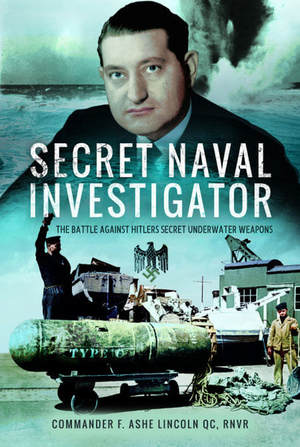When i have a chance i review the odd book or two and thought you may be interested in the latest one i did, a great book and well worth a read. The site i review for is giving away a copy in a draw if anyone is interested and uses twitter then pm me for details.
Secret Naval Investigator
Author: Cdr F. Ashe Lincoln
Publisher: Frontline Books

Secret Naval Investigator
Author: Cdr F. Ashe Lincoln
Publisher: Frontline Books

The latest offering to appear on my desk is this wonderful book 'Secret Naval Investigator' by Commander F. Ashe Lincoln QC, RNVR. This book details the battle against Hitler’s secret underwater weapons in a 182 page hardback format, published by Frontline books.
Secret Naval Investigator is one of those rare books, like ‘Unexploded Bomb’ by Major A. B. Hartley, that covers the subject of unexploded ordnance recovery and disposal with enough detail to keep any likeminded ordnance fanatics (myself included) interested. Careful editing ensures the reader does not get overwhelmed with the immense amount of technical detail associated with this dangerous role.
Initially we are introduced to the dire situation Great Britain found itself in during the early stages of World War Two. British shipping losses were at six or more a day, with a huge numbers of vessels trapped inside and outside British ports.
This was the impact of the intensive German mine laying program. Although, never publicly released, Great Britain was only a matter of weeks away from being on its knees; such was the extent of the German mining problem. Something had to be done.
With only limited training, a small unit was put together to deal with the deadly threat. Contact mines had been around for a long time but a new type was being laid - the magnetic mine.
Before any countermeasures could be devised, a specimen of the new German weapon needed to be recovered, rendered safe and transported back to HMS Vernon. The weapon needed to be dissected to reveal its deadly secrets. The Admiralty were constantly trying to keep one step ahead of the enemy. They needed to devise a method of sweeping for the highly intelligent and explosive German weapon.
As World War Two progressed, many advances to counter the threat were made by the British Admiralty. Specialist sets of non-magnetic tools and rudimentary x-ray equipment were developed. On the German side, new and more ingenious mines and torpedoes were being fitted with built in booby-traps designed to kill any person attempting to disassemble it and reveal its deadly secrets.
This book was fascinating from start to finish. I can't recommend it highly enough.
Anyone with an interest in this field of warfare will find this book invaluable.
Secret Naval Investigator is one of those rare books, like ‘Unexploded Bomb’ by Major A. B. Hartley, that covers the subject of unexploded ordnance recovery and disposal with enough detail to keep any likeminded ordnance fanatics (myself included) interested. Careful editing ensures the reader does not get overwhelmed with the immense amount of technical detail associated with this dangerous role.
Initially we are introduced to the dire situation Great Britain found itself in during the early stages of World War Two. British shipping losses were at six or more a day, with a huge numbers of vessels trapped inside and outside British ports.
This was the impact of the intensive German mine laying program. Although, never publicly released, Great Britain was only a matter of weeks away from being on its knees; such was the extent of the German mining problem. Something had to be done.
With only limited training, a small unit was put together to deal with the deadly threat. Contact mines had been around for a long time but a new type was being laid - the magnetic mine.
Before any countermeasures could be devised, a specimen of the new German weapon needed to be recovered, rendered safe and transported back to HMS Vernon. The weapon needed to be dissected to reveal its deadly secrets. The Admiralty were constantly trying to keep one step ahead of the enemy. They needed to devise a method of sweeping for the highly intelligent and explosive German weapon.
As World War Two progressed, many advances to counter the threat were made by the British Admiralty. Specialist sets of non-magnetic tools and rudimentary x-ray equipment were developed. On the German side, new and more ingenious mines and torpedoes were being fitted with built in booby-traps designed to kill any person attempting to disassemble it and reveal its deadly secrets.
This book was fascinating from start to finish. I can't recommend it highly enough.
Anyone with an interest in this field of warfare will find this book invaluable.
